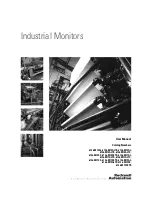
User manual, Check synchroscope CSQ-3
4189340263L (UK)
∆ϕ
, and is to expire in the period the phase is still within the phase window before the
synchronising pulse is emitted, it means in the shown example that with an actual
∆
f
of 0.049Hz the synchronising pulse would only be 18 msec. To avoid transmission of
such a short synchronising pulse, the CSQ-3 performs a calculation based on
∆
f and
the actual phase window to make room for a synchronising pulse of at least 100 msec.
Referring to example 1, 100 msec must be subtracted from the calculated t
d
to allow a
max.
∆
f of 0.05Hz.
Function in particular situations:
In connection with test “on desk” the CSQ-3 is normally connected to the same supply
point so that frequency and phase are completely identical on the generator input and
the busbar input. At this test form the following must be noticed:
The first time the CSQ-3 is connected, synchronising pulse is emitted whether the
∆ϕ
window is set symmetrically or asymmetrically. If only the busbar input is interrupted
subsequently (the CSQ-3 is supplied with auxiliary voltage from the generator input),
synchronising pulse is only emitted if the interruption has lead to the result that the
∆ϕ
window was left in connection with the interruption (occurs if the interruption results in
a noise pulse).
If
∆ϕ
is set asymmetrically so that only e.g.
positive
∆
f
is accepted and
∆
f changes
sign (inverse direction) after the phase between generator and busbar is within the
phase window, the synchronising pulse is not interrupted until the
∆ϕ
window is left,
even if
∆
f has changed sign to
negative
∆
f
.
If
∆
f is changed to correct direction of rotation after the phase is within the phase
window the CSQ-3 calculates if there is space for t
R
(the synchronising pulse), and in
that case synchronising pulse is emitted.
Errors and changes excepted

































